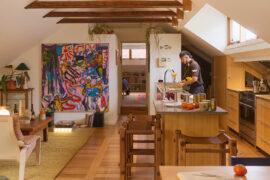Expert designer Jarrod Lim has collaborated with AI. While the process might have been interesting, the outcome is nothing less than remarkable.

January 7th, 2025
While AI is a hot topic and permeates most aspects of our lives at the moment, Jarrod Lim has taken the pairing of design and AI a step further and achieved an amazing result. Collaborating with The American Hardwood Export Council (AHEC), the Australian-Singaporean designer, Principal of Jarrod Lim Design, conceived Man x Machine x Material that was on display at the recent Interzum SEA showcase at Iffina Indonesia Meubel & Design Expo in Jakarta, Indonesia.
Lim experimented with human-computer interaction in his creation of the AHEC booth and then products, Airstream table and Diffuse stools in American red oak. With ChatGPT, Lim explored designing and making with timber in a process whose end result was remarkable.

Initially Lim commented on how he had to overcome his natural resistance to working with a non-human partner: “I needed to begin the design of the AHEC booth with an open mindset, free from preconceived notions. Initially, creating a table or stools wasn’t even part of the plan.”
Lim continues: “I engaged the AI to research the use of timber in furniture design, aiming to integrate notable Indonesian elements. This initiated a collaborative process, where the AI contributed design ideas which I then refined with my own creative insights. The outcome was a true partnership between human intuition and AI-driven innovation.”

While the first designs for Man x Machine x Material were aesthetically promising, they were not likely to be viable from a manufacturing perspective. “The specificity of prompts given to the AI were crucial for achieving a design that was both visually appealing and feasible to produce,” explains Lim. “As a designer, intuitive understanding guides what looks good and what will work. However, with AI, these intuitive elements needed to be articulated explicitly.”
The practical skills and material knowledge naturally acquired by designers such as Lim over years of trial and error in production proved a stumbling block in communication with the AI platform.
Related: Five thought-provoking stories on AI

“The AI initially provided generic timber suggestions but with prompts for sustainable and workable materials it pointed to American red oak, which is a material that is easy to work and versatile. It’s readily available, sustainable and it steams and bends easily so in a sense the material choice made up for the lack of understanding of industrial production methods.
“The AI model struggled when prompted to consider the technical aspects of production, which are second nature to a craftsman. This highlighted to me the current limitations of the AI which I found easier to resolve using my past experience rather than further instruction. While I fully appreciate the machine would maybe learn over time, communicating what I knew in a way that it could understand was too time consuming and would certainly be a problem given the usual scope of my work.”

After persevering with the AI generated ideas, Lim and his new collaborator realised a collection comprising table, stools and screen that was beautifully resolved. Lim reflects on the collaboration, noting that “this experience has been profoundly enlightening for me. Collaborating with generative AI compelled me to clearly define and articulate my design objectives.
“The AI assisted in narrowing down material choices, ultimately leading to the selection of American red oak. While we are still in the early stages of generative AI, it’s evident that this tool will become increasingly integral to the design process, similar to 3D designing years ago. Rather than replacing human design sensibilities, it serves to enhance and elevate our creative capabilities. At the end of the day I have to question whether, alone, it is capable of creating designs which people can fall in love with.”

With this project, the outcome is most definitely outstanding design but achieved through the experience and knowledge of a master such as Lim. As AI increases its expertise, things may change. However, for the moment, the human designer is in command and guiding AI in the right direction.
AHEC is a supporter of The Object category at the 2025 INDE.Awards.
Jarrod Lim
jarrodlim.com
American Hardwood Export Council (AHEC)
americanhardwood.org
American Hardwood ANZ
@ahec_anz
Photography
Courtesy of AHEC




Listen to this live-audience podcast recording with John McAslan
INDESIGN is on instagram
Follow @indesignlive
A searchable and comprehensive guide for specifying leading products and their suppliers
Keep up to date with the latest and greatest from our industry BFF's!

Gaggenau’s understated appliance fuses a carefully calibrated aesthetic of deliberate subtraction with an intuitive dynamism of culinary fluidity, unveiling a delightfully unrestricted spectrum of high-performing creativity.

Welcomed to the Australian design scene in 2024, Kokuyo is set to redefine collaboration, bringing its unique blend of colour and function to individuals and corporations, designed to be used Any Way!

Joan Montgomery Centre PLC by Warren and Mahoney is a tour de force of education design, with high-end facilities including a swimming pool and general athletic amenities.

Brad Krauskopf, CEO & Founder of Hub Australia, tells us about Hassell’s design for Hub Australia Martin Place.
The internet never sleeps! Here's the stuff you might have missed

In commercial interiors, flooring needs to do more than ground a space, it should tell a story. Through collaboration with the industry’s leading lights, Designer Rugs creates custom rugs & bespoke carpet solutions, finding ways to elevate commercial environments with material nuance and design integrity.

A new STEAM project by Life Architecture and Urban Design for St Columba’s College, in Essendon, Victoria is education design at its best.

Adelaide will debut its first city-wide design festival – every*where: Adelaide Design Week – from 20th to 24th August 2025.